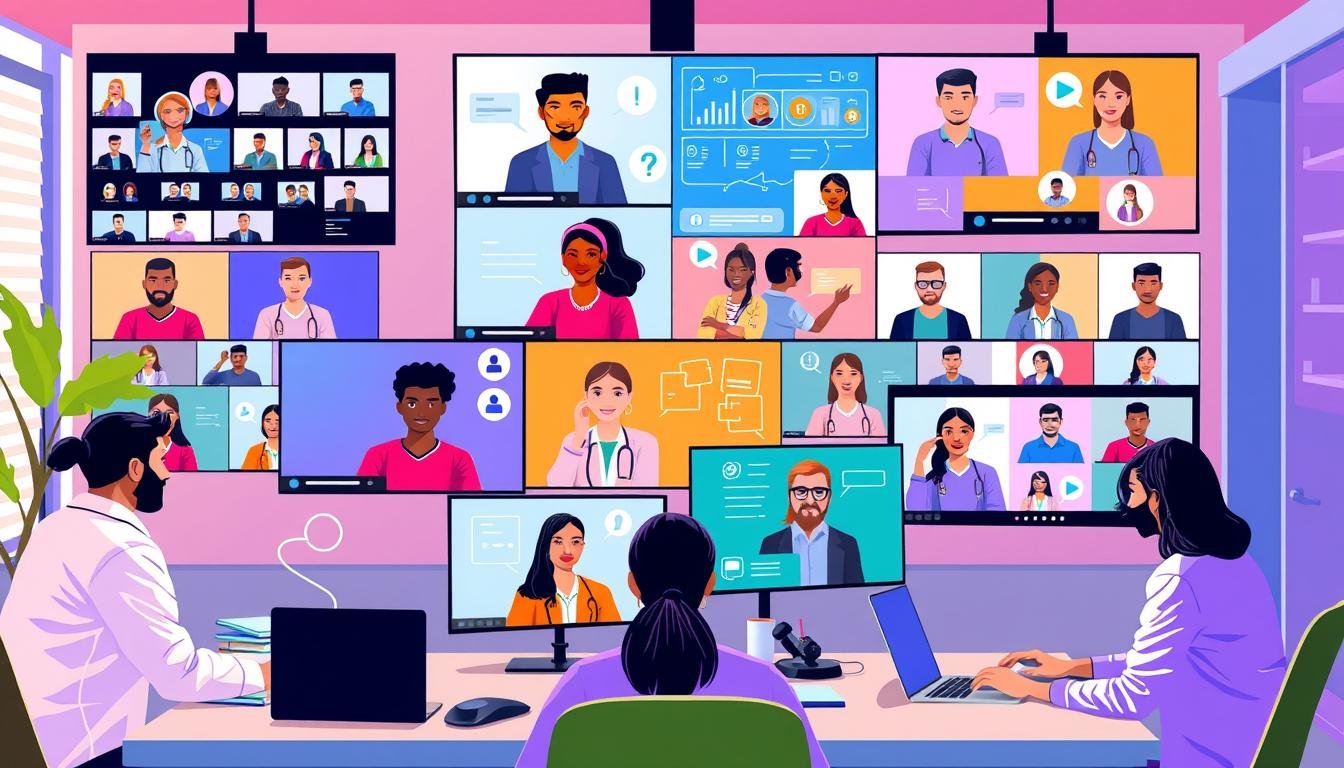Did you know that up to 70% of employees cite ineffective communication as a primary reason for workplace inefficiencies? As businesses increasingly transition to hybrid work models, mastering virtual communication strategies has never been more essential. The shift to remote work not only challenges traditional interactions but also opens up opportunities for fostering collaboration and productivity through effective virtual communication. By implementing streamlined remote communication techniques, teams can enhance engagement and ensure alignment with organizational goals.
Effective virtual communication is not just a trend; it’s a necessity for success in today’s digital landscape. The focus should be on using the right tools and frameworks that facilitate clear and concise interactions. For insights on optimizing your team’s communication practices, explore this resource to help you navigate this crucial aspect of modern workplaces.
Key Takeaways
- Effective virtual communication is critical for team collaboration and productivity.
- 70% of employees experience workplace inefficiencies due to poor communication.
- Utilizing remote communication techniques can enhance engagement.
- Hybrid work models require adaptable communication strategies.
- Clear communication frameworks align teams with organizational goals.
Understanding Virtual Communication Strategies
Virtual communication strategies encompass the methodologies and apparatuses that facilitate efficacious communication within remote settings. These strategies are paramount for sustaining team cohesion and optimizing productivity. As remote work ascends to the norm, the implementation of virtual communication best practices becomes imperative for team triumph. Clear communication catalyzes enhanced collaboration, cultivates teamwork, and elevates overall team morale.
Definition and Importance
The core of virtual communication strategies resides in their capacity to bridge individuals across geographical divides. Neglecting this facet can precipitate misunderstandings and a decline in productivity. Prioritizing clear communication is imperative, as it establishes the foundation for successful interactions and guarantees that all parties are aligned towards shared objectives. Enhancing virtual communication skills will augment both individual and collective performance, ensuring every member feels integral and esteemed.
Key Components of Effective Communication
To maximize the efficacy of virtual communication, several pivotal components must be considered:
- Clarity: Messages should be straightforward to avoid confusion.
- Timeliness: Responding promptly helps maintain the flow of conversation.
- Responsiveness: Engaging with team members fosters a collaborative environment.
Integrating these elements will substantially contribute to the enhancement of virtual communication skills within teams. By acknowledging and addressing impediments to communication, organizations can leverage virtual communication best practices to forge a more cohesive and connected team dynamic.
The Role of Technology in Virtual Communication
Technology’s pivotal role in augmenting virtual communication cannot be overstated. An array of tools and platforms has surfaced, designed to streamline interactions amongst team members, thereby facilitating efficient remote work communication strategies. Mastery of these technologies is paramount for enhancing team dynamics.
Tools and Platforms for Communication
Several virtual communication tools stand out as indispensable for effective collaboration amongst remote teams. Noteworthy platforms include:
- Slack: Ideal for instant messaging and sharing files in organized channels, fostering quick communication.
- Zoom: Favored for video conferencing, allowing real-time discussions with features like screen sharing.
- Microsoft Teams: A versatile tool that integrates chat, video meetings, and collaboration on documents, streamlining workflows.
Adoption of these tools can significantly boost productivity and fortify team relationships, thereby rendering remote work more effective.
The Impact of Technology on Team Dynamics
The integration of technology into remote work settings presents both advantages and disadvantages. On one hand, virtual communication tools enable seamless collaboration, thereby promoting teamwork and connectivity. Conversely, an over-reliance on technology can precipitate feelings of isolation amongst team members.
Teams must strive to achieve a balance in remote work communication strategies to maximize collaboration while mitigating potential drawbacks. Grasping the influence of these technologies on team dynamics is essential for cultivating a supportive and productive work environment.
Setting Clear Communication Goals
The establishment of precise communication objectives is paramount for the efficacy of virtual teamwork. These objectives serve as a compass, directing the interactions of team members and ensuring the seamless exchange of information across the organization. The formulation of well-defined goals not only unifies the team but also cultivates a productive milieu.
Establishing Objectives
The initiation of effective remote communication hinges on the setting of specific and quantifiable objectives. When team members grasp the purpose behind these communication endeavors, clarity is significantly enhanced. To achieve this, consider the following strategies:
- Identify your key performance indicators (KPIs) to measure success.
- Create objectives that are SMART: Specific, Measurable, Achievable, Relevant, and Time-bound.
- Involve the entire team in the goal-setting process for better buy-in.
Aligning Goals with Team Vision
Alignment with the overarching team vision is indispensable. Clear communication goals must mirror and bolster the broader organizational objectives. To ensure this alignment, team leaders can:
- Regularly communicate the overarching vision to maintain focus.
- Schedule periodic reviews to assess both team and individual performance against set goals.
- Encourage open discussions around the evolution of goals as the team’s vision may shift.
Best Practices for Virtual Meetings
Optimizing virtual meetings is pivotal for fostering team synergy and productivity. Adherence to strategic protocols ensures the seamless execution of these gatherings, thereby stimulating active participation among attendees. Below, we present critical virtual team communication strategies to consider.
Scheduling and Timing Tips
Given the diversity in time zones among team members, meticulous planning of meeting schedules is imperative. The following guidelines embody the essence of virtual communication best practices:
- Opt for times that align with the majority of participants.
- Employ scheduling tools to identify the most suitable meeting slots.
- Always dispatch calendar invites with a clear agenda and duration.
Engaging Participants Effectively
Meetings should foster an environment of participation and collaboration. To achieve this, incorporate the following strategies to maintain engagement:
- Initiate with icebreaker questions to establish a positive atmosphere.
- Utilize breakout rooms for facilitating smaller group discussions.
- Encourage continuous feedback and questions throughout the meeting.
Best Tools for Virtual Meetings
The selection of appropriate tools significantly enhances the virtual communication experience. Consider the following platforms:
- Zoom for video conferencing.
- Slack for messaging and file sharing.
- Trello for project management and task tracking.
Encouraging Open Communication
The establishment of an environment that promotes open communication is paramount for team success. Transparency within a team cultivates trust and collaboration, allowing members to articulate their thoughts without restraint. Through the integration of effective virtual communication strategies, teams can significantly enhance their performance and engagement.
Creating a Culture of Transparency
The genesis of a culture of transparency lies in leadership’s example. Leaders must exemplify open communication by disseminating information consistently and soliciting input from all team members. This approach fosters:
- Increased trust among team members
- A readiness to share ideas and feedback
- Improved collaboration, resulting in superior outcomes
To bolster these initiatives, training sessions focused on enhancing virtual communication skills can empower team members to express themselves confidently in a virtual setting.
Tools for Anonymous Feedback
The incorporation of tools for anonymous feedback revolutionizes the preservation of communication’s openness. These platforms enable team members to convey their concerns and suggestions without apprehension. Noteworthy tools include:
- SurveyMonkey
- Google Forms
- Slack’s Anonymous Feedback tool
Adopting these resources improves the caliber of feedback received, showcasing a dedication to valuing every team member’s contribution. By embracing these virtual communication strategies, teams can foster a more open dialogue, thereby cultivating a more salubrious work environment.
Overcoming Communication Barriers

The realm of virtual team communication is often beset by numerous impediments. The initial step towards enhancing team interactions involves the identification of these barriers. Through the adoption of strategic approaches, teams can harness remote communication techniques to facilitate clearer and more streamlined exchanges.
Identifying Common Barriers
Several prevalent barriers impede virtual communication, including:
- Cultural differences: Diverse backgrounds can precipitate misunderstandings and misinterpretations.
- Technology challenges: Technical malfunctions, such as suboptimal internet connectivity, can disrupt the flow of communication.
- Language barriers: In international teams, disparate primary languages can complicate discussions and diminish clarity.
Strategies to Mitigate Issues
Employing effective virtual team communication strategies can help circumvent these challenges. Consider the following strategies:
- Encourage a culture of openness. Team members should feel at ease in expressing concerns or posing questions.
- Utilize multiple communication tools to accommodate diverse preferences, such as video calls, instant messaging, and email, thereby enhancing flexibility in communication style.
- Provide training on technology platforms employed within the team. Familiarity with these tools can reduce frustration and enhance collaboration.
- Schedule regular check-ins to foster relationships and address any potential misunderstandings promptly.
- Be mindful of language use, opting for clear, simple language to enhance understanding across diverse cultures.
Utilizing Visual Communication Tools
Visual communication is pivotal in augmenting the efficacy of virtual interactions. The integration of visual aids within teams facilitates an enhancement in the comprehension and retention of disseminated information. This, in turn, elevates the engagement and clarity of presentations, thereby simplifying complex concepts and promoting collaborative endeavors among remote personnel.
Benefits of Visual Aids
Visual aids present a multitude of advantages within the virtual realm. Key benefits include:
- Enhanced understanding: Visual elements facilitate the clear transmission of information, thereby enabling team members to assimilate complex topics with greater ease.
- Improved retention: The incorporation of visuals enhances memory retention, leveraging the dual coding effect in cognitive processes.
- Increased engagement: Engaging visuals serve to captivate attention, ensuring team members remain focused during meetings or presentations.
Recommended Visual Communication Tools
Several virtual communication tools have emerged as pivotal in enhancing visual communication. Here are a few recommended options:
- Miro: A collaborative online whiteboard platform that enables brainstorming, planning, and visualizing projects effectively.
- Prezi: A dynamic presentation tool that allows teams to create visually captivating presentations that move beyond traditional slides.
- Canva: A user-friendly graphic design tool that helps teams create stunning visuals, including infographics and social media posts.
By leveraging virtual communication tools like these, teams can fortify their visual strategies, leading to more effective virtual communication. The adoption of these resources enhances collaboration and clarity across remote settings, rendering communication more impactful and memorable.
Maintaining Team Connectivity
In the realm of remote work, the imperative of sustaining team connectivity cannot be overstated. It is the bedrock upon which robust relationships and collaborative synergy are constructed. The implementation of efficacious communication strategies transcends mere productivity; it ensures that each team member feels an integral part of the collective effort. The incorporation of elements that are both enjoyable and interactive serves to significantly elevate team dynamics and morale.
Virtual Team Building Activities
Engagement in virtual team building activities is pivotal in bridging the physical divide. These endeavors are crafted to cultivate camaraderie and augment communication amongst team members. Several notable options include:
- Virtual Coffee Breaks: Encourage informal discussions to foster personal connections and break the ice.
- Online Trivia Games: Encourage friendly competition, thereby promoting teamwork and collaboration.
- Virtual Workshops: Organize skill-sharing sessions where team members can impart their expertise or hobbies to one another.
Regular Check-ins and Updates
Adopting a routine of regular check-ins and updates is indispensable for maintaining an informed and engaged team. This practice is in line with effective virtual team communication strategies, as it facilitates the sharing of progress and the articulation of concerns. Consider the following:
- Weekly Team Meetings: Schedule dedicated times for project updates and open discussions.
- One-on-One Check-ins: Provide a platform for team members to discuss personal challenges and achievements with leadership.
- Email Updates: Share insights on project milestones and celebrate team successes.
Navigating Time Zone Differences

Time zone disparities pose significant hurdles for global teams aiming for effective communication. To boost productivity and foster inclusivity, teams must embrace strategic remote communication methodologies. Mastery over these variations is crucial for enhancing collaboration across diverse geographical locations.
Strategies for Global Teams
Establishing a collaborative framework across time zones necessitates meticulous planning. Several effective strategies are worth considering:
- Schedule meetings during overlapping hours when most team members are available.
- Rotate meeting times to share the inconvenience of early or late calls across different time zones.
- Utilize asynchronous communication tools to allow flexibility in responses.
Tools to Help Manage Time Zones
Several tools can efficiently manage time zone differences. For example, World Time Buddy and Time Zone Converter provide user-friendly interfaces for checking time discrepancies. Integrating these tools into your workflow can streamline communication and facilitate meeting deadlines seamlessly.
Adopting these virtual team communication tips will cultivate a more cohesive team atmosphere, transcending geographical barriers. For further insights on enhancing team connectivity, refer to this helpful resource. Leveraging effective strategies and tools ensures that all voices are heard, creating an inclusive environment for every team member.
Fostering Inclusivity in Virtual Spaces
In the domain of virtual communication, inclusivity is paramount for enhancing team dynamics. The adoption of effective virtual communication strategies is essential to bridge gaps and ensure all voices are heard, irrespective of background or location. This methodology not only fosters a sense of belonging but also enriches discussions with diverse perspectives.
Best Practices for Inclusivity
Implementing best practices for inclusivity can significantly enhance team cohesion and engagement. These strategies may include:
- Encouraging participation from all team members during meetings, ensuring balanced contributions.
- Using inclusive language that respects and values the diverse backgrounds of team members.
- Providing opportunities for team members to share experiences and perspectives.
- Utilizing tools that support accessibility for all individuals.
Encouraging Diverse Perspectives
Encouraging diverse perspectives is critical for effective virtual communication. Teams must create an environment where different viewpoints are not only welcomed but celebrated. Incorporating practices such as regular brainstorming sessions where everyone can contribute ideas is advisable. Resources like strategies for maintaining inclusion can guide teams toward more holistic approaches to communication. Engaging with varied perspectives enhances problem-solving and drives innovation, ultimately benefiting the entire organization.
Measuring the Effectiveness of Communication
In a realm dominated by remote interactions, the capacity to evaluate communication is paramount for success. The assessment of virtual communication’s impact is crucial for teams to discern their areas of proficiency and deficiency. This evaluation is directly correlated with the implementation of virtual communication best practices, thereby ensuring team cohesion and efficacy.
Key Metrics to Monitor
To gauge communication effectiveness, specific metrics offer profound insights. Key areas to concentrate on encompass:
- Response Times: Observe the promptness with which team members respond to messages or requests.
- Engagement Levels: Monitor participation in meetings and discussions to measure involvement.
- Feedback Quality: Evaluate the pertinence and utility of feedback exchanged among members.
- Communication Consistency: Verify that messages are lucid and uniform across various platforms.
By concentrating on these metrics, organizations can gain a deeper understanding of their communication strategies’ dynamics and enhance overall effectiveness.
Tools for Assessing Communication Impact
Employing the appropriate tools can significantly augment the measurement of communication effectiveness. Consider the following options:
- Survey Tools: Platforms such as SurveyMonkey or Google Forms can collect feedback on communication practices.
- Analytics Software: Tools like Slack Analytics offer insights into engagement and activity levels.
- Project Management Tools: Applications such as Asana or Trello facilitate tracking of communication frequency related to project updates.
- Employee Engagement Platforms: Solutions like Officevibe measure team morale and communication comfort.
These resources provide essential data for refining virtual communication best practices, ensuring continuous improvement and effectiveness.
Continuous Improvement of Communication Strategies
In the rapidly evolving realm of remote work, the perpetual enhancement of communication strategies is paramount for optimizing team efficacy. A systematic review process is indispensable, enabling organizations to evaluate the efficacy of their virtual communication methodologies. This evaluation facilitates the identification of successful strategies and those necessitating refinement. Such a proactive stance cultivates an environment that is resilient to the evolving nature of team interactions.
Regular Review Process
Adopting a consistent review framework can markedly elevate the proficiency of virtual communication within teams. By scheduling these assessments, teams can dissect both qualitative and quantitative metrics of their communication approaches. This methodology not only underscores achievements but also reveals areas requiring enhancement, thereby stimulating continuous refinement of communication strategies.
Incorporating Feedback Loops
Furthermore, the integration of feedback mechanisms is crucial for effective communication. By fostering an environment where team members’ viewpoints are solicited, an inclusive atmosphere is cultivated, where every individual’s contribution is recognized. This exchange not only aids in pinpointing potential impediments but also energizes the collective endeavor to refine virtual communication strategies. Prioritizing candid dialogue enables teams to achieve smoother and more productive collaboration. For further insights on cultivating effective communication dynamics, refer to this resource.
